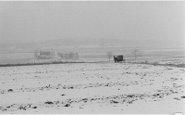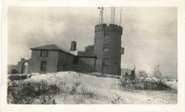Winter '22 / '23 - An over-the-horizon look at early autumn's a priori climate conditions
 |
| near Woodstock ... VT Marion Post Wolcott (1940) |
Snowfall forecasting contests for 27 stations across New England and the Mid-Atlantic regions ... since 1999
 |
| near Woodstock ... VT Marion Post Wolcott (1940) |
- Almost 60% above normal (1,620,000 SQ-KM)
- Ranks 6th during period-of-record (1967 - 2022).
- Highest since 1998 (25 years ago).
The extent of Eurasia/s OCT snow cover has been positively correlated with cold and snowy winter weather in the eastern CONUS so we/re off to a good start.
Data courtesy Rutgers University Global Snow Lab
-19.14 (just inside 1-sigma from the mean)
OCT is now the 5th month with a QBO index below zero having flipped in JUN following its 14 month run in positive territory. The 30mb flow over the Equator oscillates from east to west every 14 months; therefore ... the current easterly state of the QBO is expected to last throughout Winter '21 / '22.
Leading analog years
Winter / ENSO (MEI)
72-73 / W+
00-01 / C-
09-10 / W
91-92 / W+
58-59 / W-
With La Nina temperature anomalies in ENSO Region 3.4 expected to
persist through at least late winter ... all QBO analog years are
rejected except Winter 00/01.
- Winter '00 / '01
The sum-total of the season-total snowfall for all Contest forecast stations was 1,312". (~21% above the 1968 - 2021 period-of-record average 1,085".
Eurasia/s OCT areal snow cover slightly below normal.
D-J-F Index Averages
AO: -1.312
NAO: +0.040
 Observed: 10,671,792 km^2
Observed: 10,671,792 km^2
Average: 10,310,000 km^2
Median: 10,130,000 km^2
3.5% (5.3%) above normal (median)
Rank: 19 (n = 54)
Above average snow cover observed in 10 of the past 10 OCTs.
At least 1 standard deviation above normal snow cover in 5 of the last 10 OCTs.
These analog winters have questionable predictive value b/c a moderate La Nina (C) and QBO-E are expected to prevail during Winter '21 / '22.
Blue markers located between the inner and outer circle have a weak yet statistically significant (p <= 0.05) positive correlation between Eurasia/s OCT areal snow cover and a forecast station/s season-total snowfall. Strongest correlations found in New England where correlations range between 0.269 (BTV) and 0.376 (ORH).
A paultry ~16% of the variability (R2 = 0.158) in combined season-total snowfall from all forecast stations is explained by Eurasia/s OCT areal snow cover.
---
Period-of-Record: 1967 - 2021 (1969: no data)
Data courtesy Rutgers Global Snow Lab
Previous posts about Eurasia's OCT areal snow cover here.
~ 11,000,000 SQ-KM
Under-performing all year ...
6% above P-O-RN (~10,320,000 SQ-KM)
9% above median (~10,080,000 SQ-KM)
Period-of-Record: 53 years
Rank: 19th
2nd lowest past 10 years
16 of past 20 years above P-O-R-N
OCT-19: ~12,700,000 SQ-KM
OCT-20: 14% less than last year
Eurasia snow analog years offer little if any guidance given this winter should have cool ENSO / PDO and QBO-W.
---
P-O-RN ==> period-of-record normal
Data courtesy Rutgers University Global Snow Lab
http://climate.rutgers.edu/snowcover/index.php
Eurasia/s areal snow cover for OCT-19: ~ 12,800,000 SQ-KM
24% above 52-year P-O-R-N (~10,300,000 SQ-KM)
27% above 52-year median (~10,100,000 SQ-KM)
Rank: 7th
3rd highest past 10 years
4 of past 20 years below median ('05 ... '07 ... '08 ... '11)
OCT-18: ~10,400,000 SQ-KM
OCT-19: 23% greater than OCT-18
UPDATE (31-OCT-19)
Dr. Cohen via Tweeter ..."... the snow cover advance index came in at +0.6.
"This does suggest a negative winter Arctic Oscillation and upcoming #PolarVortex disruption."
Severe Weather Europe's (SWE) analysis of the solar cycle and ENSO analogs ...
Eurasia/s areal snow cover for SEP-19: ~1,570,000 SQ-KM
Eurasia/s areal snow cover for AUG-19: ~158,300 km2
The Snow Advance Index (SAI) measures the mean daily rate-of-change in Eurasia's areal snow cover at latitudes equatorward of 60°N during OCT. Published research suggests rapid increases in Eurasia/s OCT areal snow cover are associated with increased season-total snowfall (STP) in the eastern U.S.
Does the SAI provide useful guidance for season-total snowfall at NEWxSFC forecast stations?
REPOST from OCT-17 (lightly edited for clarity)
Updated with Winter '17 / '18 verifications for RIC and NYC and their outlooks for Winter '18 / '19
---
The correlation between the areal coverage of Eurasia/s OCT snow cover and season-total snowfall has become broad-brushed conventional wisdom (CW) following the innovative research by AER climatologist Dr. Judah Cohen.
But ... just how well does the CW hold up for NEWxSFC/s forecast stations across New England (NE) and the mid-Atlantic (M-A) regions?
To find out ... monthly period-of-record areal snow cover data for Eurasia from Rutgers Global Snow Lab were correlated with season-total snowfall data for the 27 NEWxSFC/s stations.
A positive and statistically significant correlation means the greater the areal snow cover over Eurasia in OCT ... the greater the season-total snowfall for the following winter.
An Excel radar chart shown below depicts the results of the analysis.
Cohen projecting above normal Eurasia snow cover for OCT ahead of an expected weak La Nina winter (D-J-F).
Nine previous weak La Nina winters ... including the famed 1995 - 1996 season ... have been observed during the Eurasia snow cover period of record (1967 - 2016). Only two NEWxSFC forecast stations -- BGM and ALB -- have a statistically significant correlation between season-total snowfall and above normal Eurasia snow cover.

Related:
Winter '17 / '18 - Correlation of Eurasia's OCT Snow Cover and Season-total Snowfall in NE and M-A Regions

Thread updated periodically as new outlooks and forecasts are issued from a variety of sources.
---
WxAmerica...
Since this upcoming winter season looks to be close to climatology (normal/mean appearance), the harshest period of December 23 - February 14 will likely be characterized by strong and persistent high-latitude blocking.
Whereas November and the first three weeks of December will likely have a more "up and down" or erratic character, suppressed storm tracks and strong Arctic intrusions are likely in the dead of winter.
The "January Thaw" may be short, with the potential for a fairly vast -EPO/-AO/-NAO alignment keeping colder air in play.



















